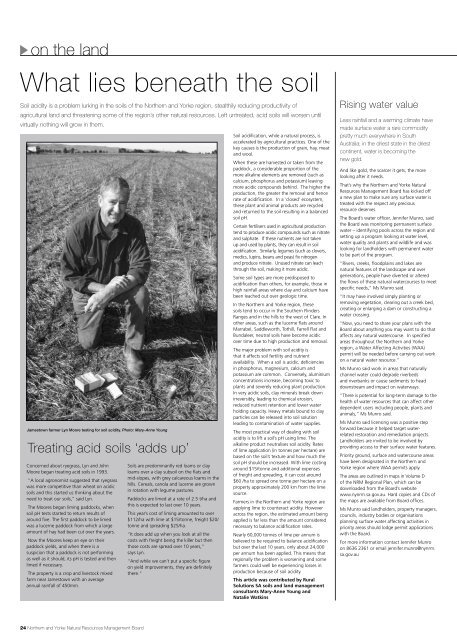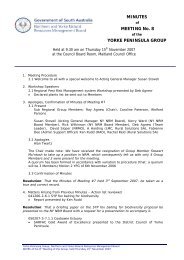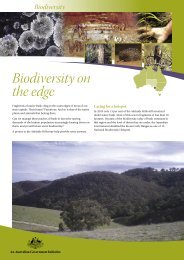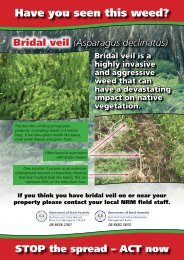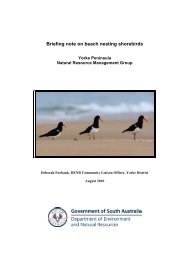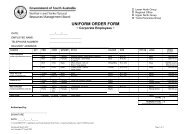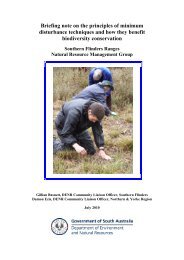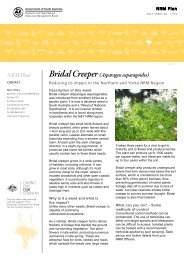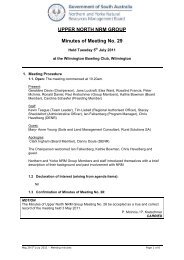Caring for country - Northern and Yorke Natural Resources ...
Caring for country - Northern and Yorke Natural Resources ...
Caring for country - Northern and Yorke Natural Resources ...
You also want an ePaper? Increase the reach of your titles
YUMPU automatically turns print PDFs into web optimized ePapers that Google loves.
4on the l<strong>and</strong><br />
What lies beneath the soil<br />
Soil acidity is a problem lurking in the soils of the <strong>Northern</strong> <strong>and</strong> <strong>Yorke</strong> region, stealthily reducing productivity of<br />
agricultural l<strong>and</strong> <strong>and</strong> threatening some of the region’s other natural resources. Left untreated, acid soils will worsen until<br />
virtually nothing will grow in them.<br />
Jamestown farmer Lyn Moore testing <strong>for</strong> soil acidity. Photo: Mary-Anne Young<br />
Treating acid soils ‘adds up’<br />
Concerned about ryegrass, Lyn <strong>and</strong> John<br />
Moore began treating acid soils in 1993.<br />
“A local agronomist suggested that ryegrass<br />
was more competitive than wheat on acidic<br />
soils <strong>and</strong> this started us thinking about the<br />
need to treat our soils,” said Lyn.<br />
The Moores began liming paddocks, when<br />
soil pH tests started to return results of<br />
around five. The first paddock to be limed<br />
was a lucerne paddock from which a large<br />
amount of hay had been cut over the years.<br />
Now the Moores keep an eye on their<br />
paddock yields, <strong>and</strong> when there is a<br />
suspicion that a paddock is not per<strong>for</strong>ming<br />
as well as it should, its pH is tested <strong>and</strong> then<br />
limed if necessary.<br />
The property is a crop <strong>and</strong> livestock mixed<br />
farm near Jamestown with an average<br />
annual rainfall of 450mm.<br />
Soils are predominantly red loams or clay<br />
loams over a clay subsoil on the flats <strong>and</strong><br />
mid-slopes, with grey calcareous loams in the<br />
hills. Cereals, canola <strong>and</strong> lucerne are grown<br />
in rotation with legume pastures.<br />
Paddocks are limed at a rate of 2.5 t/ha <strong>and</strong><br />
this is expected to last over 10 years.<br />
This year’s cost of liming amounted to over<br />
$112/ha with lime at $15/tonne, freight $20/<br />
tonne <strong>and</strong> spreading $25/ha.<br />
“It does add up when you look at all the<br />
costs with freight being the killer but then<br />
those costs are spread over 10 years,”<br />
says Lyn.<br />
“And while we can’t put a specific figure<br />
on yield improvements, they are definitely<br />
there.”<br />
Soil acidification, while a natural process, is<br />
accelerated by agricultural practices. One of the<br />
key causes is the production of grain, hay, meat<br />
<strong>and</strong> wool.<br />
When these are harvested or taken from the<br />
paddock, a considerable proportion of the<br />
more alkaline elements are removed (such as<br />
calcium, phosphorus <strong>and</strong> potassium) leaving<br />
more acidic compounds behind. The higher the<br />
production, the greater the removal <strong>and</strong> hence<br />
rate of acidification. In a ‘closed’ ecosystem,<br />
these plant <strong>and</strong> animal products are recycled<br />
<strong>and</strong> returned to the soil resulting in a balanced<br />
soil pH.<br />
Certain fertilisers used in agricultural production<br />
tend to produce acidic compounds such as nitrate<br />
<strong>and</strong> sulphate. If these nutrients are not taken<br />
up <strong>and</strong> used by plants, they can result in soil<br />
acidification. Similarly, legumes (such as clovers,<br />
medics, lupins, beans <strong>and</strong> peas) fix nitrogen<br />
<strong>and</strong> produce nitrate. Unused nitrate can leach<br />
through the soil, making it more acidic.<br />
Some soil types are more predisposed to<br />
acidification than others, <strong>for</strong> example, those in<br />
high rainfall areas where clay <strong>and</strong> calcium have<br />
been leached out over geologic time.<br />
In the <strong>Northern</strong> <strong>and</strong> <strong>Yorke</strong> region, these<br />
soils tend to occur in the Southern Flinders<br />
Ranges <strong>and</strong> in the hills to the west of Clare. In<br />
other areas, such as the lucerne flats around<br />
Marrabel, Saddleworth, Tothill, Farrell Flat <strong>and</strong><br />
Bundaleer, neutral soils have become acidic<br />
over time due to high production <strong>and</strong> removal.<br />
The major problem with soil acidity is<br />
that it affects soil fertility <strong>and</strong> nutrient<br />
availability. When a soil is acidic, deficiencies<br />
in phosphorus, magnesium, calcium <strong>and</strong><br />
potassium are common. Conversely, aluminium<br />
concentrations increase, becoming toxic to<br />
plants <strong>and</strong> severely reducing plant production.<br />
In very acidic soils, clay minerals break down<br />
irreversibly, leading to chemical erosion,<br />
reduced nutrient retention <strong>and</strong> lower water<br />
holding capacity. Heavy metals bound to clay<br />
particles can be released into soil solution<br />
leading to contamination of water supplies.<br />
The most practical way of dealing with soil<br />
acidity is to lift a soil’s pH using lime. The<br />
alkaline product neutralises soil acidity. Rates<br />
of lime application (in tonnes per hectare) are<br />
based on the soil’s texture <strong>and</strong> how much the<br />
soil pH should be increased. With lime costing<br />
around $15/tonne <strong>and</strong> additional expenses<br />
of freight <strong>and</strong> spreading, it can cost around<br />
$60 /ha to spread one tonne per hectare on a<br />
property approximately 200 km from the lime<br />
source.<br />
Farmers in the <strong>Northern</strong> <strong>and</strong> <strong>Yorke</strong> region are<br />
applying lime to counteract acidity. However<br />
across the region, the estimated amount being<br />
applied is far less than the amount considered<br />
necessary to balance acidification rates.<br />
Nearly 60,000 tonnes of lime per annum is<br />
believed to be required to balance acidification<br />
but over the last 10 years, only about 24,000<br />
per annum has been applied. This means that<br />
regionally the problem is worsening <strong>and</strong> some<br />
farmers could well be experiencing losses in<br />
production because of soil acidity.<br />
This article was contributed by Rural<br />
Solutions SA soils <strong>and</strong> l<strong>and</strong> management<br />
consultants Mary-Anne Young <strong>and</strong><br />
Natalie Watkins<br />
Rising water value<br />
Less rainfall <strong>and</strong> a warming climate have<br />
made surface water a rare commodity<br />
pretty much everywhere in South<br />
Australia; in the driest state in the driest<br />
continent, water is becoming the<br />
new gold.<br />
And like gold, the scarcer it gets, the more<br />
looking after it needs.<br />
That’s why the <strong>Northern</strong> <strong>and</strong> <strong>Yorke</strong> <strong>Natural</strong><br />
<strong>Resources</strong> Management Board has kicked off<br />
a new plan to make sure any surface water is<br />
treated with the respect any precious<br />
resource deserves.<br />
The Board’s water officer, Jennifer Munro, said<br />
the Board was monitoring permanent surface<br />
water – identifying pools across the region <strong>and</strong><br />
setting up a program looking at water level,<br />
water quality <strong>and</strong> plants <strong>and</strong> wildlife <strong>and</strong> was<br />
looking <strong>for</strong> l<strong>and</strong>holders with permanent water<br />
to be part of the program.<br />
“Rivers, creeks, floodplains <strong>and</strong> lakes are<br />
natural features of the l<strong>and</strong>scape <strong>and</strong> over<br />
generations, people have diverted or altered<br />
the flows of these natural watercourses to meet<br />
specific needs,” Ms Munro said.<br />
“It may have involved simply planting or<br />
removing vegetation, clearing out a creek bed,<br />
creating or enlarging a dam or constructing a<br />
water crossing.<br />
“Now, you need to share your plans with the<br />
Board about anything you may want to do that<br />
affects any natural watercourse. In specified<br />
areas throughout the <strong>Northern</strong> <strong>and</strong> <strong>Yorke</strong><br />
region, a Water Affecting Activities (WAA)<br />
permit will be needed be<strong>for</strong>e carrying out work<br />
on a natural water resource.”<br />
Ms Munro said work in areas that naturally<br />
channel water could degrade riverbeds<br />
<strong>and</strong> riverbanks or cause sediments to head<br />
downstream <strong>and</strong> impact on waterways.<br />
“There is potential <strong>for</strong> long-term damage to the<br />
health of water resources that can affect other<br />
dependent users including people, plants <strong>and</strong><br />
animals,” Ms Munro said.<br />
Ms Munro said licensing was a positive step<br />
<strong>for</strong>ward because it helped target waterrelated<br />
restoration <strong>and</strong> remediation projects.<br />
L<strong>and</strong>holders are invited to be involved by<br />
providing access to their surface water features.<br />
Priority ground, surface <strong>and</strong> watercourse areas<br />
have been designated in the <strong>Northern</strong> <strong>and</strong><br />
<strong>Yorke</strong> region where WAA permits apply.<br />
The areas are outlined in maps in Volume D<br />
of the NRM Regional Plan, which can be<br />
downloaded from the Board’s website<br />
www.nynrm.sa.gov.au. Hard copies <strong>and</strong> CDs of<br />
the maps are available from Board offices.<br />
Ms Munro said l<strong>and</strong>holders, property managers,<br />
councils, industry bodies or organisations<br />
planning surface water affecting activities in<br />
priority areas should lodge permit applications<br />
with the Board.<br />
For more in<strong>for</strong>mation contact Jennifer Munro<br />
on 8636 2361 or email jennifer.munro@nynrm.<br />
sa.gov.au<br />
24 <strong>Northern</strong> <strong>and</strong> <strong>Yorke</strong> <strong>Natural</strong> <strong>Resources</strong> Management Board


